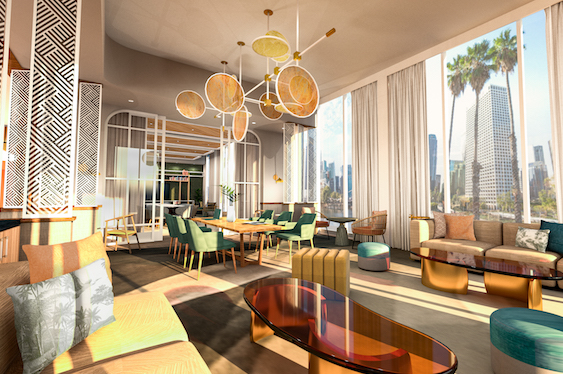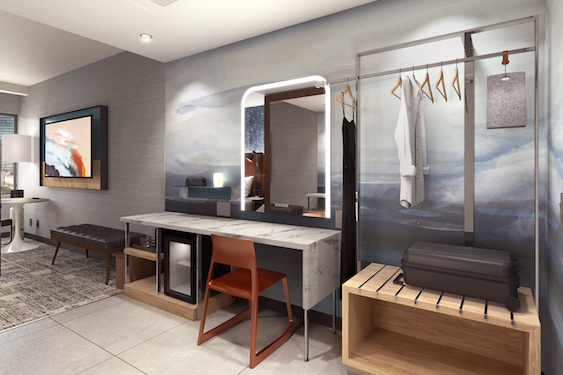There’s no question that COVID-19 is one of, if not the biggest, challenges the hotel industry has faced in the past 20 years. But, despite chilling RevPAR and occupancy slides, not to mention employee furloughs, including at Hilton itself, it’s not the time to stop thinking about the future. So, what will Hilton’s newest brand bring to the post-coronavirus travel world when it comes online in 2021 or 2022?
Hilton CEO Christopher Nassetta has sliced the consumer pie with a sharp knife. Not only is Tempo by Hilton the company’s 18th brand, it’s an entrant — some may say a late entrant — into the hypercompetitive upscale select-service niche.
The company is positioning it into a relatively tight slot within the Hilton brand family, between Hilton Garden Inn and Canopy by Hilton. Phil Cordell, the company’s head of new brand development, isn’t fazed by that.
“Hilton Garden Inn is consistent. Each hotel is almost identical,” he said. “Canopy is completely bespoke. Tempo is in between.” Tempo also will be placed onto a very specific development map. Of the 30 signed deals in the U.S., Cordell said about 70% are urban and 30% are suburban/urban, in locations including both gateway cities and smaller, but hot, markets.
In the next 30 or so signings, he said, Tempo will add more suburban locations (it’s important to note that the “right neighborhood” is still key; don’t expect roadside Tempo properties).

Contributed by Oriana Lerner
What’s the anatomy of this new offer, and what does Cordell think differentiates it from the multitude of other flags hovering near the same price point and development map? The marketing language describing Tempo as “elevated and approachable” or “designed for the modern achiever” echoes the sales-speak other hotel giants have used to promote lifestyle brands for the past few years. Tempo was built on the data from a 10,000-person consumer survey. That information showed that “lifestyle” means, at least to these guests, exactly that.
“I try to be my best self at home, but fitness and sleep can get disrupted when I travel,” said Cordell. Survey respondents agree, and helping travelers maintain their lifestyle on the road is the guiding principle of everything in the flag.
Guest room design
The guest room design is a case in point. Nelson Worldwide worked on the design with Hilton, and while the company’s executive vice president, Tom Horwitz, calls Tempo a “non-prototype prototype,” the guest room is a fairly rigid standard, which is typical of upscale select service. There is a large “get ready zone” at the entrance with a long horizontal surface for doing exactly as its name implies, eating or working. The chair tilts forward to ease looking into the mirror or seeing a laptop screen.
Instead of the wall-mounted pegs seen in other flags, the wardrobe has been replaced by a freestanding piece that combines a clothing rack and space for a steamer. A bench works for storage or lounging. The bed has an enveloping headboard that offers connectivity.
Near the window, an oval table, chair and floor lamp provide a flexible area for eating, working or chatting with someone on the bench or the bed across the room. Two small tables replace nightstands and leave space for an upholstered chair in the king room. A large bathroom is separated from the guest room by mirrored barn doors.

That’s a lot of FF&E: Tempo’s design is something of a reaction to the trend for streamlining the FF&E package to include as few items as possible.
“Hilton’s team and the guests both wanted to take the complexity out of travel,” said Horwitz. For this group, self-explanatory furnishings made more sense.
“We haven’t seen pushback from owners on the design — they ‘got’ why this works,” he added. Costs are kept in line by eliminating big-ticket pieces such as nightstands, for which there is no demonstrated demand, and exchanging them for more maneuverable alternatives (the tables by the bed cost roughly half as much as a nightstand and are easy to clean behind, an additional advantage that might take on a new importance in a post-virus industry).
TVs become digital art, eliminating a line item for wall-mounted pieces. Upgrades such as a mix of LVT and carpet on the floors are not going to be mandated.
The public areas will offer owners more flexibility to suit the site. Key points will include a “look up” moment, which is an architectural detail on the ceiling designed to get guests away from their devices and into the moment. A minimum 1,000-square-foot gym is an upgrade to fitness offers from similar flags, although Cordell is quick to say that the focus at Tempo is on wellness, not just fitness. Programming, such as an extensive non-alcoholic cocktail menu and energizing and relaxing in-room programs in partnership with Thrive global, round out the flag’s mission statement.
It might sound good on paper for guests and owners alike, but Is this viable enough to get traction? “There are a lot of different components in Tempo, so I think the pressure will be on Hilton’s ability to market them,” said Tanya Pierson, managing director of HVS. She’s also not too concerned about the impact of COVID-19 on the rollout. Due to the broad-based appeal of Tempo, she thinks, even if 2021 and 2022 openings are delayed by issues getting construction supplies and FF&E, the flag will still debut “on time” as far as consumer demands go. She also believes that while its core appeal is to existing Hilton owners, it may open up a new ownership group: wellness investors, such as spa companies, looking to diversify.
Of course, it’s hard to predict anything in this market, but Tempo does stand for a major shift in thinking: lifestyle as a keyword for functionality, not design.
“I’m not sure our audience will stop and notice a designer chair in the room, though there is an appreciation for elevated design overall,” said Cordell. But there is room to unroll a yoga mat, both in the entry and by the window. The design team checked that.
